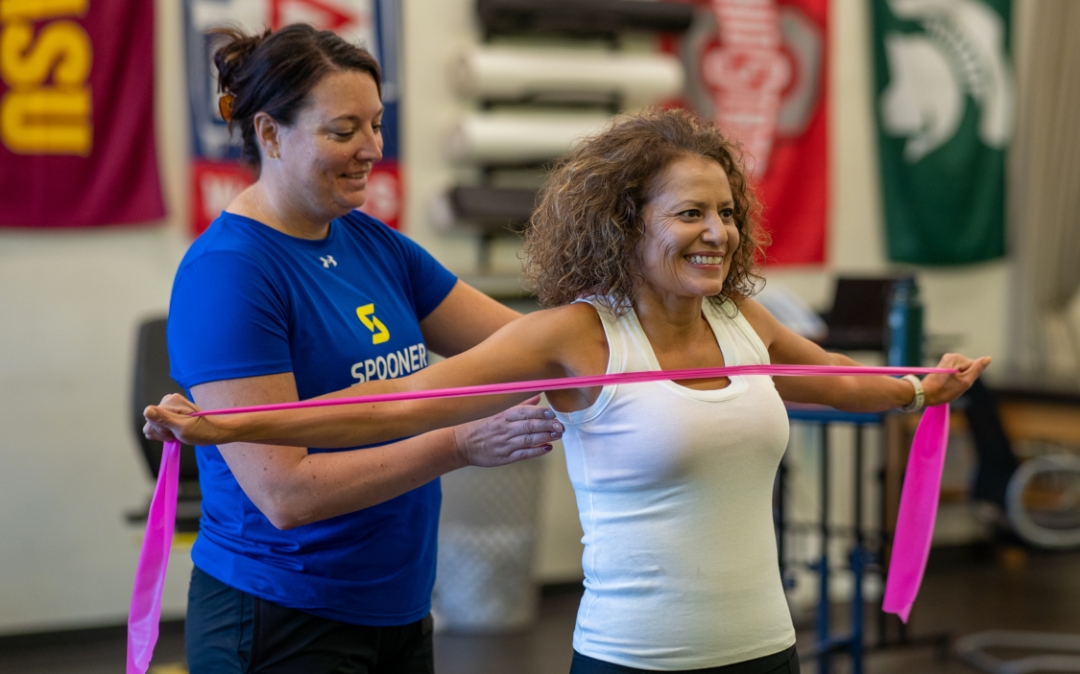A 32-year-old woman is going to yoga classes 5 days a week. A 41-year-old-woman is training to perform better in her next triathlon. A 28-year-old woman is going to her CrossFit gym 3 or more days a week. These women are extremely active; they are athletes leading a healthy lifestyle and doing what they love, but, when each of them gets diagnosed with various stages of breast cancer, their activity levels inevitably change.
Treatment, surgery, and life after cancer will make exercise difficult. However, physical therapy can help each survivor return to the sport or activity they love after treatment. We talked to Jenna Salber, PT, DPT, CLT-UE, NASM-CES, to learn more about returning to sport after breast cancer treatment.
What is the functional impact of breast cancer-related surgery?
When you have a mastectomy or any type of reconstruction, there can be limitations with your shoulder mobility, thoracic spine mobility, and your upper body strength.
With certain types of reconstruction, your core can also be very much impacted based on incisions and downtime following surgery. Your ability to activate your core influences your balance, proprioception, and awareness of yourself in space.
A lot of times, there will be limitations and restrictions with activity. This could come in the form of lifting restrictions of no more than five to 10 pounds for a certain number of weeks. You may also have limitations with drains and incisions as far as not being able to get submerged in water or sweat.
What about radiation and chemotherapy?
With radiation in particular, you can have skin breakdown and tightness in some of the fascia and muscles in the area of treatment. This can cause changes in your posture, your strength, and your mobility.
With chemotherapy, there are a lot of side effects that can affect your overall activity tolerance. One common side effect of chemotherapy is damage or dysfunction to peripheral nerves– or neuropathy- which can affect your balance and proprioception. It also can limit your tolerance to being on your feet or activities that require use of your hands.
Treatment induced fatigue can make day-to-day tasks difficult to complete. If you are able to stay active during chemo, you are likely not going to be able to maintain your normal duration or intensity of workout.
With that being said, it’s important to try to stay as active as you can without over-fatiguing yourself. This could cause delayed recovery with chemotherapy.
How do you help as a physical therapist?
Initially, we want to try to restore your range of motion and biomechanics of the entire body. We focus specifically on the upper body, due to surgeries, but we do take a whole-body approach.
Once we restore range of motion and biomechanics, we work on gradually increasing your strength. Goal setting is huge here, because we start with achieving strength for functional day-to-day activities, and then we take into account the specific activities you want to return to. If you have goals to swim, or get back to yoga or Pilates, or gain strength to return to your CrossFit gym, or complete a triathlon, we make sure we are helping you train for and get back to doing what is most important to you.
With general deconditioning that can happen as a side effect of all of the treatments, it’s important that we gradually reintroduce you into the activities that you want to do.
We want to make sure your range of motion and strength are at a level where you are not at risk of secondary injury when returning to your sport. There are specific return to sport tests that we will incorporate into treatment to ensure you can tolerate the stressors of the sport you are going back to.
How do you help survivors return to their sport?
Setting specific guidelines for return to sport is critical. Going back to an activity that you haven’t been doing for a period of time, alongside surgery, chemo, and radiation, needs to be scaled.
If, before treatment, a triathlete’s normal weekend workout included 4-5 hours of training on a Saturday, that workout might take weeks of recovery after going through cancer treatments. Gradually increasing the parameters of the workout can help with energy levels and strength along the way. We may start with lower-level activities, like walking or biking. Once you’re consistently and comfortably able to perform less demanding activity we can gradually reintroduce you into running through a walk jog program. The same can be said with swimming–gradually increasing duration and intensity over time after meeting certain milestones.
If you want to return to weight training, we will first work on the mechanics of lifting. Working on proper form is our first step. With lifts like the bench or overhead press, we are going to make sure you have the mobility to perform the actual movement. The same can be said with squatting; establishing good mechanics is the first priority. Once proper mechanics are in place, we can begin adding load and building strength.
For yoga or Pilates, we are going to, again, start with the mobility to see if you can tolerate the extremes that occur in these practices. Making sure that you can tolerate being in a plank and going through a chaturanga without pain or any significant compensations through shoulder, thoracic spine or hips is something that we are going to be looking for. We will make sure you can tolerate one or two flows inside the clinic on a mat, and then gradually help you work up to a full class or working on a Reformer.
Overall, we want to help you return to your sport safely. Give yourself a lot of grace through this process, as it will take time. But, together, we can help you get back to the activities you love.
Spooner breast health therapists are on your team to help you return to your sport after cancer treatments. Schedule an appointment today!

